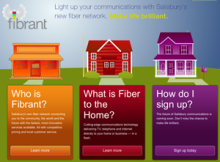Salisbury's Fibrant Making A Difference in Area Schools
Salisbury's Fibrant network in North Carolina was recently praised in a letter to the editor of a local paper for improving the educational tools in schools. These networks can have a big impact on educational opportunities, from directly improving the connections to the schools (often at lower prices) to lowering the cost of broadband across the entire community, thereby increasing broadband adoption and giving a new educational tool to children in home.
Previously, when the computers in our lab were being used, the entire system was bogged down. We had to limit the use of video and Skype to class periods where the lab computers were not being used. With some programs, we were not able to have a full class on the computers at the same time. ... Next up, we will be able to establish full connectivity between the main building and the kindergarten building. This will enable our phones, paging system, and file sharing to work together for the first time ever, and we are very excited about that!




 The question is why they want faster connections. Only 20% say their current connection completely meets their need to conduct online testing and assessment applications - with another 44% saying it "mostly" meets those needs.
The question is why they want faster connections. Only 20% say their current connection completely meets their need to conduct online testing and assessment applications - with another 44% saying it "mostly" meets those needs.
 These gaps represent a tremendous opportunity for growth - communities should be building their own fiber-optic connections to connect these key institutions and ensure they will have affordable, fast, and reliable connections well into the future. By owning the network, these institutions will have greater control over future costs and their capacity to take advantage of even newer applications.
The FCC should favor locally owned networks to encourage self-reliance instead of never-ending subsidies to private carriers who have little incentive to lower prices and increase investment.
These gaps represent a tremendous opportunity for growth - communities should be building their own fiber-optic connections to connect these key institutions and ensure they will have affordable, fast, and reliable connections well into the future. By owning the network, these institutions will have greater control over future costs and their capacity to take advantage of even newer applications.
The FCC should favor locally owned networks to encourage self-reliance instead of never-ending subsidies to private carriers who have little incentive to lower prices and increase investment.